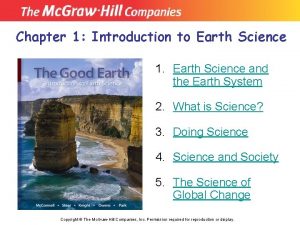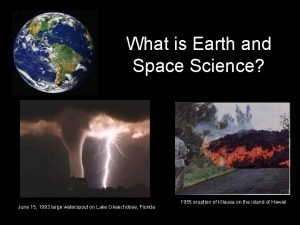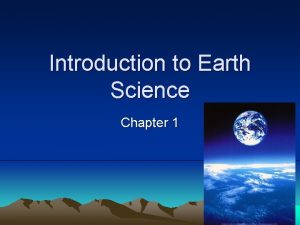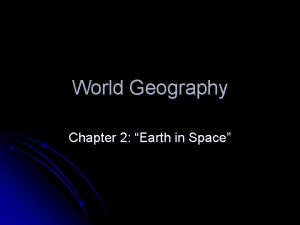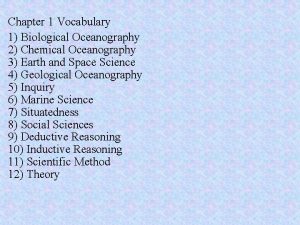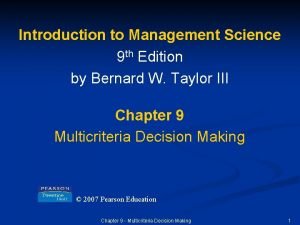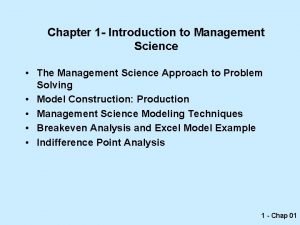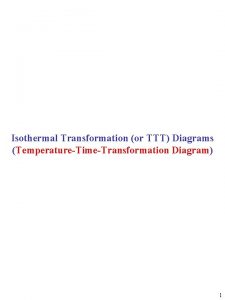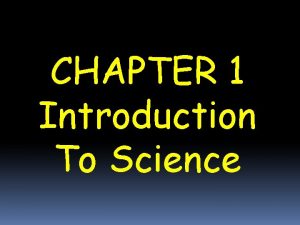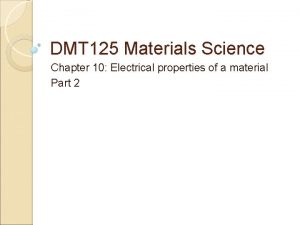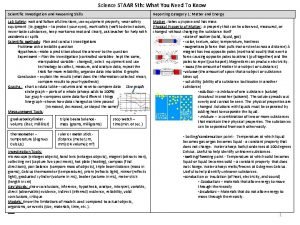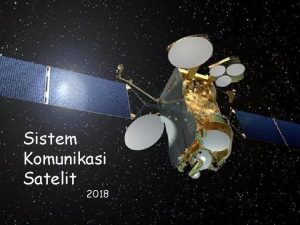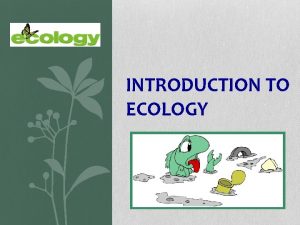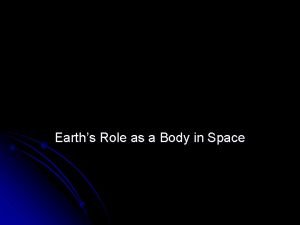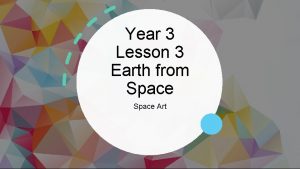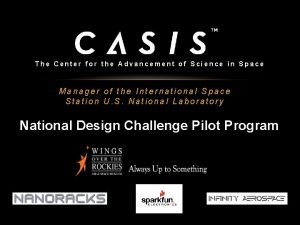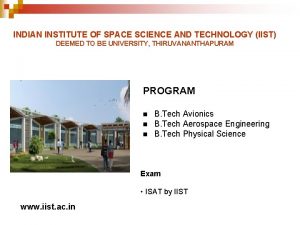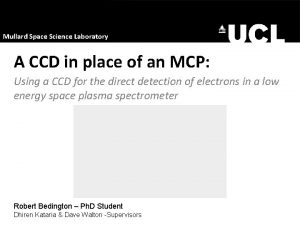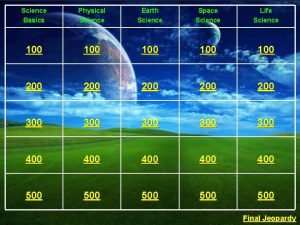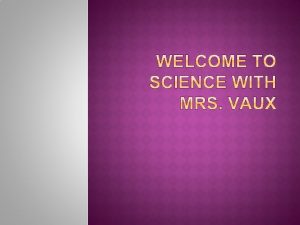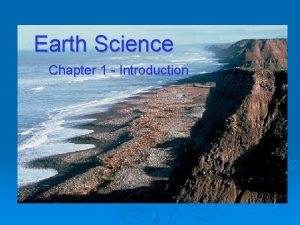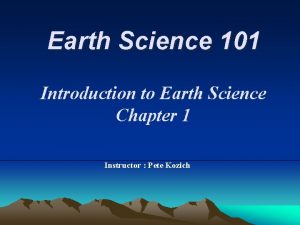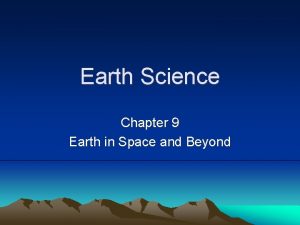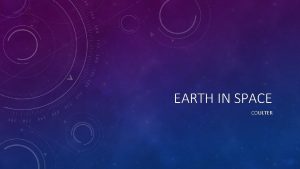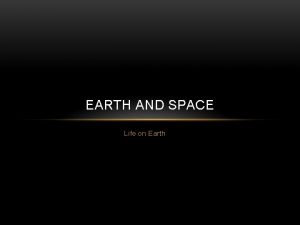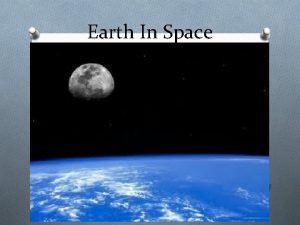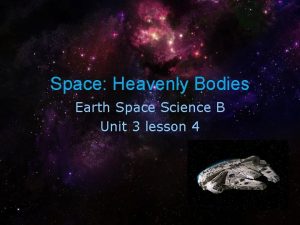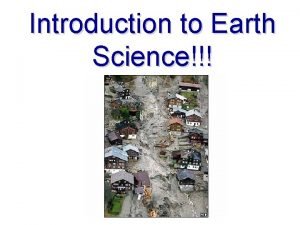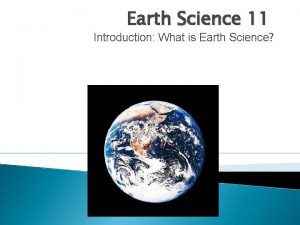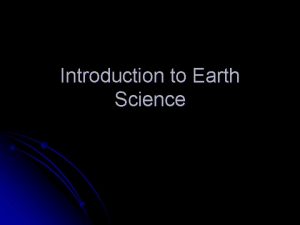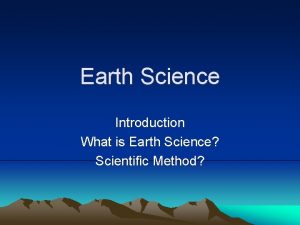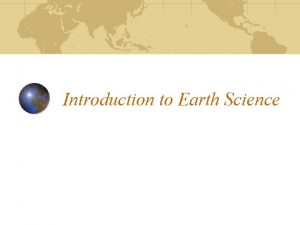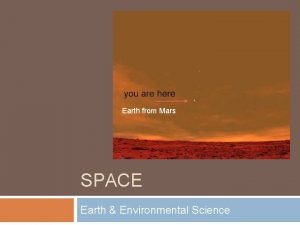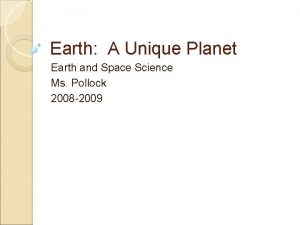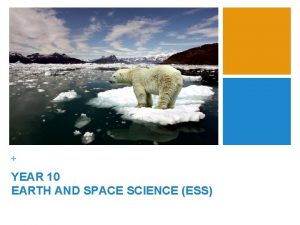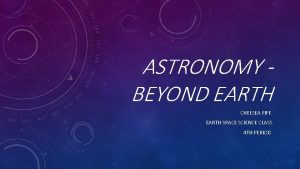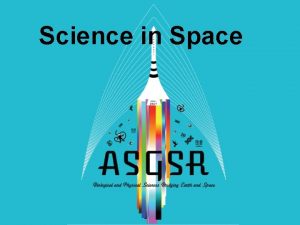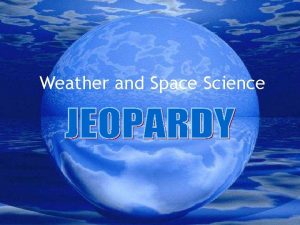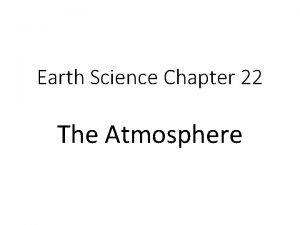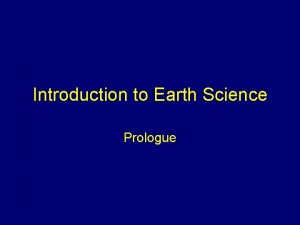EARTH SPACE SCIENCE Chapter 1 Introduction to Earth

























- Slides: 25

EARTH & SPACE SCIENCE Chapter 1 Introduction to Earth Science 1. 2 Science as a Process

1. 2 Science as a Process Objectives • Explain how science is different from other forms of human endeavor. • Identify the steps that make up scientific methods. • Analyze how scientific thought changes as new information is collected. • Explain how science affects society.

Introduction • It is the main goal of science that separates it from other human endeavors such as philosophy, art, and architecture. • Any human endeavor may include science as a component, such as exercising scientific method to determine which design is best for constructing an arch in a building. • The main goal of science is to explain natural phenomena.

Behavior of Natural Systems • It is assumed in science that phenomena are both natural and understandable. • It is also expected that similar forces in a similar situation will cause similar results. • Efforts are made to link cause and effect even when many variables are part of the system being studied. • With enough understanding, it is possible to make predictions of natural phenomena.

Behavior of Natural Systems • For example, if a person is bitten by a tse-tse fly that carries Trypanosoma, then that person is likely to develop the symptoms of African sleeping sickness. • Trypanosoma (cause) is the agent and African sleeping sickness is the disease (effect).

Scientific Methods • Scientific methods are not a rigid step-bystep system found on a checklist. • Scientific methods are guidelines to scientific problem solving that have been developed over time by the scientific community. • A scientific method may be thought of as an organized, logical approach to solving a research problem.

Scientific Methods

Scientific Methods • Scientific investigations usually begin with observation. • Observation is the process of obtaining information by using the senses. • Observations lead one to ask questions or state problems. • Most questions/problems can be answered/solved by researching the topic and looking at the work of other scientists. • Sometimes, however, a question/problem remains unanswered/unsolved.

Scientific Methods • The next step is to form a hypothesis. • A hypothesis is a testable educated guess that attempts to answer the question or solve the problem. • Hypotheses are often based on known facts about similar events and derived through careful observation and analysis. • Once formulated, a hypothesis must be tested.

Scientific Methods • An experiment is a carefully planned procedure that tests a hypothesis. • A variable is any factor that can be changed in an experiment. • Independent variables are factors that can be changed by the person conducting the experiment. • Dependent variables are variables that change as a result of a change in independent variables.

Scientific Methods • Only one independent variable can be changed or tested at a time. • A control group is the standard of comparison and it may be though of as the components of an experiment that do not change. • As the experiment is conducted, it is essential that accurate and consistent records be maintained. • At the conclusion of the experiment, the data are then put into a usable form and analyzed.

Scientific Methods • The analysis of the data will allow the investigating scientist to draw a conclusion that supports or refutes the hypothesis. • Both expected and unexpected results can lead to further study and broaden the investigating scientist’s knowledge of the natural world. • Once a conclusion is reached, the work can be shared with the scientific community through professional journals, books, conferences, etc.

Scientific Measurements and Analysis • Measurement is the most important method of gathering information that a scientist can use. • The International System of Units (SI) is the standard of measurements used by scientists around the world to allow them to communicate in a common set of units. • All SI units are based on an interval of 10.

Scientific Measurements and Analysis • When recording measurements, both accuracy and precision are important. • Accuracy refers to how close a measurement is to the true value of the thing being measured. • Precision is the exactness of the measurement. • For example, a distance measured in millimeters is more precise than a distance measured in centimeters, though both may be very accurate.

Scientific Measurements and Analysis • How accurate a measurement is depends primarily on who is taking the measurement. • The precision of a measurement is determined primarily by the device used to measure the quantity.

Scientific Measurements and Analysis • Error is an expression of the amount of imprecision and variation in a set of measurements. • Confidence interval or percentage deviation is usually used to express error such as in political polls. • When a controlled experiment is impossible, a scientists may make many observations and gather additional evidence to compare how the hypothesis fits with the additional data.

Scientific Measurements and Analysis • A model is a description, imitation, or representation of an object in the natural world. • Models are often used to simulate conditions in the natural world. • Models may be classified into different categories. – – Physical (globe) Conceptual (endosymbiont hypothesis) Mathematical (E=mc 2) Computer (weather maps on the evening news)

Which One is a Scientific Model?

Acceptance of Scientific Ideas • Scientific journals and professional meetings are the most common way to communicate scientific information. • Professional journals often have a specified format for submission of peerreviewed articles. • Many professional journals are now online to allow for quicker and more environmentfriendly distribution.

Acceptance of Scientific Ideas • Peer review is the process in which experts in a given field examine the results and conclusions of a scientist’s study before that study is accepted for publication. • The peer review process acts like a filter to ensure that only well-supported ideas are published. • After original publication, an idea may be the focus of many more experiments and publication. • The original idea may become disproved, modified, or accepted.

Acceptance of Scientific Ideas • A theory is the explanation for some phenomenon that is based on observation, experimentation, and reasoning. • A theory must be supported by a large quantity of evidence and must not conflict with any existing experimental results or observations. • A theory may be thought of as an explanation that is consistent with all existing tests and observations. • A scientific law is a general statement that explains how the natural world behaves under certain conditions, but does not explain how.

Acceptance of Scientific Ideas • Cooperation between many scientific disciplines is necessary to solve problems in the natural world. • For example, the impact hypothesis proposed to explain the Cretaceous. Tertiary extinction event draws on information from paleontology, geology, physics, chemistry, astronomy, and climatology.

Science and Society • Scientific knowledge helps us to understand our world. • Science is used to develop new technology and processes. • Science has an obligation to consider both positive and negative consequences of new developments.

References • Trypanosoma http: //faculty. plattsburgh. edu/jose. deondarza/Bio 103/Handouts/notes_13. htm • Scientific Method (left) http: //is. asu. edu/plb 108/course/scimeth/page 4. ht ml • Scientific Method (right) http: //biotech. biology. arizona. edu/Scientific_Met hod/scientific_method. html • Callipers http: //www. toolsnextday. ltd. uk/vernierclp/verniercaliper. htm

References • Ruler http: //www. unitmath. com/um/p/FAQ/Precis ion. html • Einstein Model http: //maniera. wbp. zabrze. pl/foto/humor/ka rykatury/page_02. htm • Fashion Model http: //www. viewimages. com/partneryahoo/source/images. aspx? id=51627412
 Chapter 1 introduction to earth science
Chapter 1 introduction to earth science Space definition in science
Space definition in science My favorite subject is science because
My favorite subject is science because Earth science introduction
Earth science introduction Extra credit
Extra credit Chapter 2 the earth in space answers
Chapter 2 the earth in space answers Chemical oceanography definition
Chemical oceanography definition Introduction to management science chapter 5 solutions
Introduction to management science chapter 5 solutions Introduction to management science chapter 1 solutions
Introduction to management science chapter 1 solutions Introduction to materials science for engineers chapter 10
Introduction to materials science for engineers chapter 10 Non luminous flame
Non luminous flame Introduction to materials science for engineers chapter 10
Introduction to materials science for engineers chapter 10 Chapter 1 introduction to forensic science and the law
Chapter 1 introduction to forensic science and the law Cartesian space trajectory planning
Cartesian space trajectory planning Space junk the space age began
Space junk the space age began Camera space to world space
Camera space to world space Cartesian space vs joint space
Cartesian space vs joint space Ndc to screen space
Ndc to screen space Reporting category 3 earth and space
Reporting category 3 earth and space Pada komunikasi satelit, yang termasuk segmen bumi adalah
Pada komunikasi satelit, yang termasuk segmen bumi adalah This insulates our earth from the deep cold of space
This insulates our earth from the deep cold of space Earth's role as a body in space
Earth's role as a body in space Earth from space art
Earth from space art Center for the advancement of science in space
Center for the advancement of science in space Indian institute of space science and technology
Indian institute of space science and technology Mullard space science laboratory
Mullard space science laboratory
